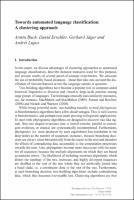Chapter Towards automated language classification
A clustering approach
| dc.contributor.author | Buch, Armin | |
| dc.contributor.author | Erschler, David | |
| dc.contributor.author | Jäger, Gerhard | |
| dc.contributor.author | Lupas, Andrei | |
| dc.contributor.editor | Saxena, Anju | |
| dc.contributor.editor | Borin, Lars | |
| dc.date.accessioned | 2019-11-19 23:55 | |
| dc.date.accessioned | 2020-01-07 16:47:06 | |
| dc.date.accessioned | 2020-04-01T09:26:38Z | |
| dc.date.available | 2020-04-01T09:26:38Z | |
| dc.date.issued | 2013 | |
| dc.identifier | 1006432 | |
| dc.identifier.uri | http://library.oapen.org/handle/20.500.12657/23712 | |
| dc.description.abstract | In this paper, we discuss advantages of clustering approaches to automated language classification, describe distance measures used for this purpose, and present results of several proof-of-concept experiments. We advocate the use of probability based distances – those that take into account the distribution of relevant features across the language sample in question | |
| dc.language | English | |
| dc.subject.classification | thema EDItEUR::C Language and Linguistics::CF Linguistics | en_US |
| dc.subject.other | linguistic differences | |
| dc.title | Chapter Towards automated language classification | |
| dc.title.alternative | A clustering approach | |
| dc.type | chapter | |
| oapen.identifier.doi | 10.1515/9783110305258.303 | |
| oapen.relation.isPublishedBy | 2b386f62-fc18-4108-bcf1-ade3ed4cf2f3 | |
| oapen.relation.isPartOfBook | d344d431-123c-48b3-94be-c8d10c495b20 | |
| oapen.relation.isFundedBy | 7292b17b-f01a-4016-94d3-d7fb5ef9fb79 | |
| oapen.relation.isbn | 9783110488081 | |
| oapen.collection | European Research Council (ERC) | |
| oapen.place.publication | Berlin/Boston | |
| oapen.grant.number | 324246 | |
| oapen.grant.acronym | EVOLAEMP |

